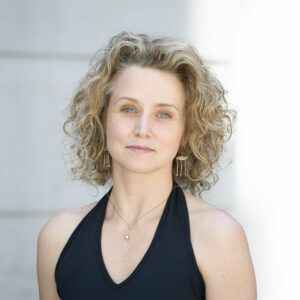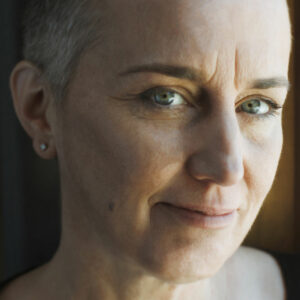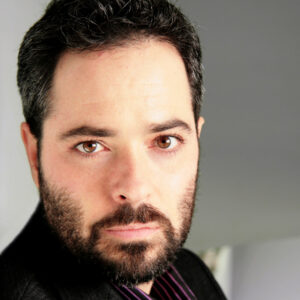Stéphanie Jasmin
Laureate, 2018
Image: Name, Title, Description
01
2018 Laureate
“The Siminovitch Prize for a designer is certainly one of the few Canadian and even international awards given to artisans who work on the shadows; those who conceive a part of the dream that will take shape on a theatrical stage. It is with humility, joy and gratitude that I receive this honour to be nominated by the jury as finalist for this prestigious prize. I consider this “highlighting” as a real encouragement to continue to dig, to explore, and to deepen this work as a designer of images and spaces for the stage. This nomination gives me an incredible impetus as an artist to pursue my path and my search within a living and collective art form which I am passionate about and which is based on human connection.”
UBU co-artistic director Stéphanie Jasmin has a degree in art history from the École du Louvre in Paris, with a specialty in contemporary art, and a BA in filmmaking from Concordia University in Montreal. On joining the company in 2000, she began contributing her knowledge of visual arts and her command of the language of video and film to Denis Marleau’s ongoing exploration of new technologies. In addition to acting as artistic collaborator and/or co-director, she has designed the video for more than 30 UBU productions and designed the sets for more than half of them. She has written and directed two original stage plays, a portrait of sculptor Michel Goulet (Éditions Varia, 2007) and a number of specialized texts on the theatre. Since 2005, she has also been working as a dramaturg with several Quebec women choreographers. She regularly hosts creative workshops in Montreal and Europe.
Acceptance Speech
This evening, I am profoundly honoured to receive the Siminovitch Prize. I am, moreover, honored to have been nominated together with you, Camellia, Alexander and Itai, all three distinguished by such remarkable artistic trajectories.
I am also very moved, for it has taken me years to believe that I have truly earned a place in the theatre world. Coming, rather, from a background in art history and cinema, I had no training in the dramatic arts. Nonetheless, upon reflection, I realize that even as a child I had, despite my timidity, an urge to share my artistic intuitions and creative desires with others precisely by way of theatre. In my village school, in Neuville, I made up stories and assigned roles that I had my friends act out during recess. Together we mounted these plays in front of the other school children, in numerous performances on a small stage. It was spontaneous, an impulse. From where this impulse came, I cannot say, but it was clearly there. My childhood was nourished by books, which were everywhere in the house, for I had the good fortune to have extraordinary parents who always encouraged my curiosity about things and the world at large. I read constantly, voraciously, one book after another. This is how I did my travelling, projecting myself into fictions, exotic lands, other lives. I was also drawing all the time. For me, images and words have always been inextricably bound together, each nourishing the other.
My first shock in confronting an image occurred when just a child, as I faced paintings in the village church. Large nineteenth-century compositions by the painter Antoine Plamondon, arranged sequentially as episodes in a story to be told. The painting that made the greatest impression on me depicted an angel slaying a grimacing devil and threatening it with its lance in a rocky, indeterminate landscape. I later discovered that is was a copy of Saint Michael Vanquishing Satan by the Italian artist Raphael. This painting terrified me; it haunted me. It exuded a dramatic strength and a strange theatricality; the painting’s two protagonists were suspended in one moment, one movement, locked in opposing attitudes. It was an open window on a fragment of a story that escaped me.
My fascination with this window on other realities, the work of art, later led me to attend the Louvre School in Paris. Years of study during which I was able, by encountering artworks in their materiality and presence, to nourish my artistic eye. I filled myself with them, observing their construction and function. Museums constituted a parallel city for me. I visited them daily, returning time and again to see a particular painting or sculpture, to draw or photograph specific details, like hands or brush strokes, that became miniature abstract compositions embedded in the large old paintings. This precious period of study and contemplation was certainly one of the most formative in my life. Moments of internal creation, moments in which we build nothing concrete, but nonetheless build many things within us. Years later, I returned to the Louvre to pace the halls with my daughter Clara. Rediscovering the artworks through my daughter’s eyes, I delighted in her comments on the Virgins in the Madonna and Child scenes, with their blue veils and long blond hair: some clearly enchanted by their babies, others not even looking at them! At the age of three, this is what concerned her most…
After this incubation period in Paris, I was moved to further explore my creation of images by pursuing studies in cinema. The painting-as-window became the framework for my composition of filmed images, an aesthetic that demanded creation, with actors and temporal duration. An image that I have subsequently had to create and construct before viewing, mounting it with many other sequences to create a fictional language of its own. The “film production” specialty was part of the Fine Arts Faculty at Concordia University. This specific feature of the program is crucial, for it was really about cinema, not as an important part of a cultural industry, but first and foremost as an art form, to experience and explore as such. Among those to whom I am particularly grateful is Marielle Nitoslawska, who taught me there with passion and epitomized for me the woman artist, she who was a photo and film director. Then, theatre entered my life, or rather it returned. It united, once again, my two passions, word and image. It became for me a sort of vast creative terrain in which to try out the experience of a real, concrete presence of bodies, places, images, and words in a single moment. A moment lived intimately through the presence and circulation of souls and bodies, and of words and ideas; a moment of communion open to a looking and listening that facilitates the passage of different states of mind, the movement from reverie to agitation, stunned wonder to wakefulness, of human thought. An experience that can apprehend the whole simultaneously, at a single glance. A glance, however, that is constantly in relation to other glances. In the auditorium as on the stage.
We are never alone with the theatre. Our first artistic intuitions, rough, incomplete, and sometimes improbable need to be shared at once with others, to be, at last, fully revealed in front of spectators. Thus, my encounter with theatre immediately plunged me into the heart of creation, the need to choose, the making of decisions, the following through with ideas, rendering them real and tangible. Theatre, as is often said, is a brutal art for it is true that the deadline, the looming certainty of the premiere, sometimes transforms it to a vertigo-inducing extreme sport. But it is often from this tension that it draws its force; it pushes us to commit to and expose what was no more than an imaginary vision and to confront it and offer it to others on the stage.
We are never alone in a theatrical work in the throes of construction. How, first of all, would I have flourished as an artist without the profound and fruitful collaboration that has bound me to Denis Marleau for almost twenty years? When I met him, he was already a well-known artist and director in the theatrical scenes of Quebec and Europe. His curiosity and passion for the visual arts, and for other arts in general, important and natural outgrowths of his conception of the theatrical art, allowed me, with my influences and scattered knowledge that came from elsewhere, to feel immediately welcome. His confidence prompted me to go ahead and present and elaborate my ideas head-on, and to create my images on the stage. The history of this spiritual sympathy and creative partnership continues to unfold, and when I reflect on all these experiences we have lived together, I am deeply grateful to him for having given me the chance to learn so much by his side, to conceive and elaborate my own artistic projects in the heart of a company whose theatrical mode of thought gains depth and complexity with each new production. I will also take this opportunity to thank the small but formidable UBU team, Lina, Gabrielle and Sylvain, who make my artistic dreams possible, as well as Jean-Michel Sivry who is UBU’s president but also a friend and first viewer whose artistic sensitivity has accompanied us for so many years.
In theatre, we are never alone. I am also grateful to Pierre Laniel, who gives technical support to each of my creations with sensitivity, openness, and a great inventiveness that allow me to realize even the most impossible of my video conceptions.
When I read a text, spaces very quickly form in my spirit and often these spaces are so well tied to the images that spring from them that a scenographic conception arises on its own. Video images and scenography are thus composed in unison. I return, therefore, to the first frame, for in my view theatrical representation is also in itself a global image, a representation to be seen, read, and felt in the same way as a painting. If the characters and the text are at the heart of the representation, they are also shuffled about, defined, determined by a sensible world that surrounds them and in which they evolve. There is, therefore, a visual aesthetic to be established, created, which, it strikes me, is every bit as essential as words.
In theatre, we are never alone. I must also thank Stéphane Longpré, collaborator, just recently named director of the École nationale de théâtre’s scenography program, who has so often helped me with his good judgment and generosity in our artistic creation meetings, ever refining the technical design of my props all the way to the completed stage set. I also acknowledge a deep admiration for Michel Goulet, a great artist and scenographer who has taught and intrigued me a great deal by his way of engaging in the underlying ideas of text and its multiple meanings, inventing scenic form that is autonomous and powerful on its own, like a sculpture or an installation.
We are never alone in theatre. There are also those who welcome our ideas, our desires and dare to believe in the project we have in our heads even before it exists… I am, therefore, grateful to Ginette Noiseux, director of Espace GO, for her confidence in me for almost ten years. Her inquisitive spirit, vibrant and caring, encouraged me and allowed me, among other things, to concretize this year on the stage my text Les Marguerite (s), which synthesizes, after a fashion, my work on image, for it is as much a scenic as a poetic writing; the scenography and video image being tied to the sense itself of the story which is told.
In theatre, we are never alone. If our relationship is direct, frontal and in the immediate present with the spectator, we also need interceders, mediators to relay its trace, its memory, synthesizing its relevant issues, prolonging its reflection. I must also thank Marie-Christine Lesage, a great analyst with a fine sensibility and a clear and brilliant mind, who facilitates the resonance of our theatrical practice both with students and in her writings, she, notably, who so successfully gives a voice to my work in her book Paysages UBU.
In theatre, we are never alone. And in the current state of the world which polarizes ever more people with extreme ideas that too often fragment and isolate the individual consciousness in fear and closed-mindedness, this meeting place, this place of assembly and discovery that is the theatre, becomes even more essential, precious. In a world where certainty, opinion and hasty responses are over-valorized, theatre encourages questions, doubts, critical distance, research and reflection. Reflection as thought, but also literally as reflection, a reflection distinct from the world to see it differently, speak it differently, dream it differently. Yes, reflection, for artists, in truth, do not invent so much. Sometimes they look at and observe just a bit better, longer, more attentively things, landscapes, people and draw our attention to the smallest details that nobody notices, like the universal matters that bind us all together.
Thus, I see theatre as an abstract, but not a mimesis, of the world. I see theatre as an experience of the other, of their difference, of their way of seeing, thinking, and speaking. I feel like a “transmitter” who relays the thought and imaginary world of an author, with its shadows and lights, one who accompanies the actors’ breath by inventing the armature that supports the actors. It is, at one and the same time, a work of creation that takes form on its own, which issues from my intimate experiences, but also displaces me, ceaselessly teaching me empathy, in its simplest definition: the capacity to intuitively put oneself in one’s neighbors’ place, to feel the same thing they feel, to identify with them. I borrow the words of Baudelaire, who spoke of imagination as the art of “revealing the intimate and secret connections of things, correspondences and analogies.” It is a “power of knowledge.” We are always learning.
And just as we will never be alone in the theatre, the value, the relevance and the impact of this Siminovitch Prize is to remind us that this collective impulse that is theatrical creation is constituted above all by the uniqueness of the singular voice of each participating artist. And it is as an artist, alone this evening before you, that I receive with gratitude this honoring of my work as an enormous encouragement and a great inspiration to its continued pursuit, as much as to the transmission, in turn, of my knowledge and passion to those who are just beginning their journey.
Thank you for your attention.
2018 Protégé
02
Simi News
Subscribe today to the monthly e-newsletter.
> Be the first to know about current artistic projects of the Siminovitch Prize community.
> Learn about emerging artists who are shaping the future of Canadian theatre.
> Stay informed about upcoming opportunities and calls for nominations.





